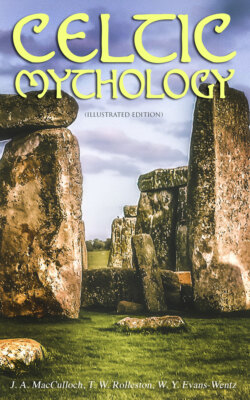Читать книгу CELTIC MYTHOLOGY (Illustrated Edition) - T. W. Rolleston - Страница 4
На сайте Литреса книга снята с продажи.
Earliest References
ОглавлениеIn the chronicles of the classical nations for about five hundred years previous to the Christian era there are frequent references to a people associated with these nations, sometimes in peace, sometimes in war, and evidently occupying a position of great strength and influence in the Terra Incognita of Mid-Europe. This people is called by the Greeks the Hyperboreans or Celts, the latter term being first found in the geographer Hecatæsus, about 500 B.C.1
Herodotus, about half a century later, speaks of the Celts as dwelling “beyond the pillars of Hercules”—i.e., in Spain—and also of the Danube as rising in their country.
Aristotle knew that they dwelt “beyond Spain,” that they had captured Rome, and that they set great store by warlike power. References other than geographical are occasionally met with even in early writers. Hellanicus of Lesbos, an historian of the fifth century B.C., describes the Celts as practising justice and righteousness. Ephorus, about 350 B.C., has three lines of verse about the Celts in which they are described as using “the same customs as the Greeks”—whatever that may mean—and being on the friendliest terms with that people, who established guest friendships among them. Plato, however, in the “Laws,” classes the Celts among the peoples who are drunken and combative, and much barbarity is attributed to them on the occasion of their irruption into Greece and the sacking of Delphi in the year 273 B.C. Their attack on Rome and the sacking of that city by them about a century earlier is one of the landmarks of ancient history.
The history of this people during the time when they were the dominant power in Mid-Europe has to be divined or reconstructed from scattered references, and from accounts of episodes in their dealings with Greece and Rome, very much as the figure of a primæval monster is reconstructed by the zoologist from a few fossilised bones. No chronicles of their own have come down to us, no architectural remains have survived; a few coins, and a few ornaments and weapons in bronze decorated with enamel or with subtle and beautiful designs in chased or repoussé work—these, and the names which often cling in strangely altered forms to the places where they dwelt, from the Euxine to the British Islands, are well-nigh all the visible traces which this once mighty power has left us of its civilisation and dominion. Yet from these, and from the accounts of classical writers, much can be deduced with certainty, and much more can be conjectured with a very fair measure of probability. The great Celtic scholar whose loss we have recently had to deplore, M. d'Arbois de Jubainville, has, on the available data, drawn a convincing outline of Celtic history for the period prior to their emergence into full historical light with the conquests of Cæsar,2 and it is this outline of which the main features are reproduced here.
